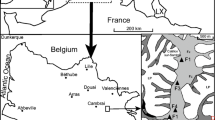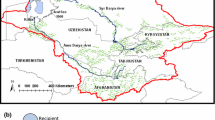Abstract
We used the interdisciplinary model network REGFLUD to predict the actual mean nitrate concentration in percolation water at the scale of the Weser river basin (Germany) using an area—differentiated (100 m × 100 m) approach. REGFLUD combines the agro-economic model RAUMIS for estimating nitrogen surpluses and the hydrological models GROWA/DENUZ for assessing the nitrate leaching from the soil. The areas showing predicted nitrate concentrations in percolation water above the EU groundwater quality standard of 50 mg NO3/l, have been identified as priority areas for implementing nitrogen reduction measures. For these “hot spot” areas a backward modelling approach was used to quantify the maximal permissible nitrogen surplus levels in agriculture to guarantee a mean long-term nitrate concentration in percolation water below 50 mg NO3/l. Research work will directly support the implementation of the EU-Water Framework Directive in the Weser basin, e.g. by using the maximal permissible nitrogen surplus levels as a framework for the derivation of regionally adapted and hence effective nitrogen reduction measures.






Similar content being viewed by others
References
Bartels R, Pluquet E, Sponagl H (1991) Boden-Dauerbeobachtungsflächen im Niedersächsischen Bodeninformationssystem. Geol J A126:107–116
Bogena H, Kunkel R, Schobel T, Schrey HP, Wendland E (2005) Distributed modeling of groundwater recharge at the macroscale. Ecol Model 187:15–26
Brouwer R, Hofkes M, Linderhof V (2008) General equilibrium modelling of the direct and indirect economic impacts of water quality improvements in the Netherlands at national and river basin scale. Ecol Econ 66:127–140
Cypris C (2000) Positive mathematische Programmierung (PMP) im Agrarsektormodell RAUMIS. Schriftenreihe der Forschungsgesellschaft für Agrarpolitik und Agrarsoziologie e.V. Bd. 313, zugl. Dissertation Universität Bonn, Bonn
European Parliament and Council of the European Union (ed) (2000) Directive 2000/60/EC of the European Parliament and the Council of the European Union of 23 October 2000 establishing a framework for Community action in the field of water policy. Off J Eur Communities. L:327
European Parliament and Council of the European Union (ed) (2006) Directive 2006/118/EC of the European Parliament and of the Council of 12 December 2006 on the protection of groundwater against pollution and deterioration. Off J Eur Communities. L 327/19
FGG Weser (2005) Bewirtschaftungsplan Flussgebietseinheit Weser—Bestandsaufnahme 2005. http://www.fgg-weser.de/wrrl/bericht_2005.html
Gauger T (2007) National implementation of the UNECE convention on long-range Transboundary air pollution (Effects)—Part 1: deposition loads; Final Report UFOPLAN FKZ 204 63 252)
Gilbert N, Maltby S, Asakawa T (2002) Participatory simulations for developing scenarios in environmental resource management. In: Urban C (ed) Third workshop on agent-based simulation. SCS Europe Bvba, Ghent, April 7–9, pp 67–72
Gömann H, Kreins P, Kunkel R, Wendland F (2004) Model based impact analysis of policy options aiming at reducing diffuse pollution by agriculture: a case study for the river Ems and a sub-catchment of the Rhine. Environ Model Softw 20:261–271. doi:10.1016/j.envsoft.2004.01.004
Groenendijk P, Renaud LV, Roelsma J, Griffioen J, van der Grift B, Janssen G, Jansen S (2008) Compliance checking level of nitrate in groundwater. Investigations of lowering the depth to 5 m below the phreatic surface with a regional leaching model. Wageningen, Alterra, Alterra-report_18_09_08.doc. 149
Henrichsmeyer W, Cypris C, Löhe W, Meudt M, Sander R, von Sothen F, Isermeyer F, Schefski A, Schleef K-H, Neander E, Fasterding F, Helmcke B, Neumann M, Nieberg H, Manegold D, Meier T (1996) Entwicklung eines gesamtdeutschen Agrarsektormodells RAUMIS96. Endbericht zum Kooperationsprojekt. Forschungsbericht für das BML (94 HS 021). http://www.faa-bonn.de/RAUMIS96.pdf. (03.03.2008)
Howitt RE (1995) Positive mathematical programming. Am J Agric Econ 2(77):329–342. doi:10.2307/1243543
Köhne C, Wendland F (1992) Modellgestützte Berechnung des mikrobiellen Nitratabbaus im Boden. Interner Bericht, KFA-STE-IB 1/92, Forschungszentrum Jülich
Kölle W (1990) Nitratelimination im Aquifer—Reaktionspartner und Mechanismen. In: Walther W (ed) Grundwasserbeschaffenheit in Niedersachsen—Diffuser Nitrateintrag, Fallstudien—Institut für Siedlungswasserwirtschaft. TU Braunschweig 48:129–145. Braunschweig
Kreins P, Gömann H, Herrmann S, Kunkel R, Wendland F (2007) Integrated agricultural and hydrological modelling within an intensive livestock region. Adv Econ Environ Resour 7:113–143. doi:10.1016/S1569-3740(07)07006-X
Kunkel R, Wendland F (1997) WEKU—A GIS-supported stochastic model of groundwater residence times in upper aquifers for the supraregional groundwater management. Environ Geol 30:1–9. doi:10.1007/s002540050126
Kunkel R, Wendland F (2002) The GROWA98 model for water balance analysis in large river basins–the river Elbe case study. J Hydrol (Amst) 259:152–162. doi:10.1016/S0022-1694(01)00579-0
Kunkel R, Wendland F (2006) Diffuse Nitrateinträge in die Grund- und Oberflächengewässer von Rhein und Ems. Schriften des Forschungszentrums Jülich, Reihe Umwelt/Environment, Band 62, Forschungszentrum Jülich GmbH, Jülich
Kunkel R, Eisele M, Schäfer W, Tetzlaff B, Wendland F (2008) Planning and implementation of nitrogen reduction measures in catchment areas based on a determination and ranking of target areas. Desalination 226:1–12. doi:10.1016/j.desal.2007.01.231
LBEG (2006) Leitfaden für die Auswahl von geeigneten Grundwassermessstellen für die niedersächsischen Grundwasserkörper im Rahmen des Grundwassermonitorings gemäß E.G.-WRRL. Pdf
Lindenschmidt K-E, Hattermann F, Mohaupt V, Merz B, Kundzewicz ZW, Bronstert A (2007) Large-scale hydrological modelling and the water framework directive and floods directive of the European Union—10th workshop on large-scale hydrological modelling. Adv Geosci 11:1–6
Matthies M, Berlekamp J, Lautenbach S, Graf N, Reimer S (2003) Decision support system for the Elbe river water quality management. Proceedings ModSim 2003, Townsville, pp 284–289
Montzka C, Canty M, Kreins P, Kunkel R, Menz G, Vereecken H, Wendland F (2008) Multispectral remotely sensed data in modelling the annual variability of nitrate concentrations in the leachate. Environ Model Softw 238:1070–1081
Moore RV, Tindall CI (2004) The HarmonIT project and the development of the OpenMI: a standard interface for model linking. In: Hydrology: science practice for the 21st century, vol I. British Hydrological Society, pp 322–328
Mysiak J, Sigel K, Brouwer R, Klauer B (2004) Uncertainty in the economic analysis according to the WFD. http://upem.er.dtu.dk/files/15%20Mysiak.pdf
NLWKN (2006) WAgriCo – water resources management in cooperation with agriculture. http://www.nlwkn.niedersachsen.de/master/C38689604_N38837740_L20_D0_I5231158.html
Pulido M, Andreu J, Solara A, Pérez MA (2005) Economic valuation and optimization of water systems management. From microeconomic data to basin scale results. A computable general equilibrium approach to the estimation of the direct and indirect economic costs of water quality improvement in the WFD. International workshop ‘Integrated River Basin Modelling and the EU Water Framework Directive’, 17–18 November 2005, Vrije Universiteit Amsterdam. 37-6EED42E0AD3E75F4/subsectionid/6608DD66-F873-446A-A6499714168C4DBB
Renger M, Wessolek G (1996) Berechnung der Verdunstungs-Jahressummen einzelner Jahre. DVWK-Merkblatter Wasserwirtschaft 238:295–305
Tetzlaff B, Kreins P, Kunkel R, Wendland F (2007) Area-differentiated modelling of P-fluxes in heterogeneous macroscale river basins. Water Sci Technol 55(3):123–131. doi:10.2166/wst.2007.080
US Soil Conservation Service (1972) National engineering handbook (chapter 4: hydrology). 2nd reprint. U.S. Dept. of Agriculture, Washington, DC
Wendland F, Kunkel R (1999) Das Nitratabbauvermögen im Grundwasser des Elbeeinzugsgebietes. Schriften des Forschungszentrums Jülich, Reihe Umwelt/Environment, Band 13, Forschungszentrum Jülich GmbH, Jülich
Wendland F, Kunkel R, Tetzlaff B, Dorhofer G (2003) GIS-based determination of the mean long-term groundwater recharge in Lower Saxony. Environ Geol 45:273–278. doi:10.1007/s00254-003-0879-x
Wendland F, Bogena H, Goemann H, Hake JF, Kreins P, Kunkel R (2005) Impact of nitrogen reduction measures on the nitrogen loads of the river Ems and Rhine (Germany). Phys Chem Earth 30:527–541
Wendland F, Kunkel R, Gömann H, Kreins P (2007) Water fluxes and diffuse nitrate pollution at the river basin scale: interfaces for the coupling of agroeconomical models with hydrological approaches. Water Sci Technol 55:133. doi:10.2166/wst.2007.081
Acknowledgments
This project was commissioned by Germany’s Federal Ministry of Food, Agriculture and Consumer protection (BMELV), the River Basin Commission Weser (RBC Weser) and the Federal States Bremen, Hessen, Niedersachsen, Nordrhein-Westfalen, Sachsen-Anhalt and Thüringen.
Author information
Authors and Affiliations
Corresponding author
Rights and permissions
About this article
Cite this article
Wendland, F., Behrendt, H., Gömann, H. et al. Determination of nitrogen reduction levels necessary to reach groundwater quality targets in large river basins: the Weser basin case study, Germany. Nutr Cycl Agroecosyst 85, 63–78 (2009). https://doi.org/10.1007/s10705-009-9248-9
Received:
Accepted:
Published:
Issue Date:
DOI: https://doi.org/10.1007/s10705-009-9248-9




